Michelle: What is the meaning of the name Aspartime in relation to your artistic intentions together? Why did you choose to play off of the spelling of the better-known artificial sweetener called “Aspartame”?
Aspartime: We believe being artists is not a profession. Artists should be a kind of existence with the most freedom possible. “Part-time” is our attitude towards art – light-hearted, natural and without additives. We don’t wish to be confined by the mundane labels. Aspartame is an artificial sweetener, how safe it actually is has always been a topic of argument, whether it is good or bad, positive or negative, it will always be a controversy. We find it fun, and it fits with our taste, and so we replaced a letter in Aspartame to Aspartime, which then became our name.
Michelle: Why did you choose to form Aspartime together instead of continuing to work separately as independent artists?
Aspartime: We hope Aspartime would be a way of substituting individual creation. We hope Aspartime could personalize a project, an event, a manifesto, a virtual reality, or even an existence without reason.
Michelle: What does your artistic process look like as a duo? Do you feel you are able to work seamlessly through a kind of linear process together, or do you have to continually compromise and shift your individual ideas to form the essence of what Aspartime is?
Aspartime: We have our own individual book of ideas, where we record some rough ideas and proposals. We discuss them, disagree with each other, but always come to some sort of conclusion. The final idea is always a result of conflict and compromise.
Michelle: In 2012 you were in a show at Star Gallery called “Nowhere to Live,” curated by Wei Guo. The curatorial idea behind the show was to explore visions of one’s place in the world—“conveying a sense that looking for a place to be and exist is a basic concern for all of us.” How do you think this topic relates to the two of you as contemporary Chinese artists today?
Aspartime: At the time we wanted to discuss the relationship between art works and the gallery space besides the fact that the works are being displayed in the space. There was a neon light piece that took apart the Chinese characters of Star Gallery – “星空间”; a piece that measured the temperature of the gallery spotlights; a sculpture made with the Nowhere to Live poster; and a piece using a dozen languages to describe the art works. These four pieces of work were all made specifically for Star Gallery. We deliberately made new works that targeted at this exhibition, also partly to avoid serious topics, at that time we were warming up for our Update and Taobao projects, slowly shaping our interests and direction.
Michelle: Do you work most of the year living in China or abroad? How do you choose to separate your time between places? Does this influence your artwork or process?

Aspartime: We have just started living between two places and it’s been quite an unusual experience. It will have great impact on our work, which is also something that we are excited about — traveling back and forth, recuperating and releasing energy, with our experiences and concepts washing like tidal waves.
Michelle: On May 16th, 2012, you began your first online network project called “Update”, where you used the popular Weibo microblogging website as a platform to display art. What was the turning point that drew you to see the Internet as a place for displaying art outside of traditional methods of exhibition usually found in China?
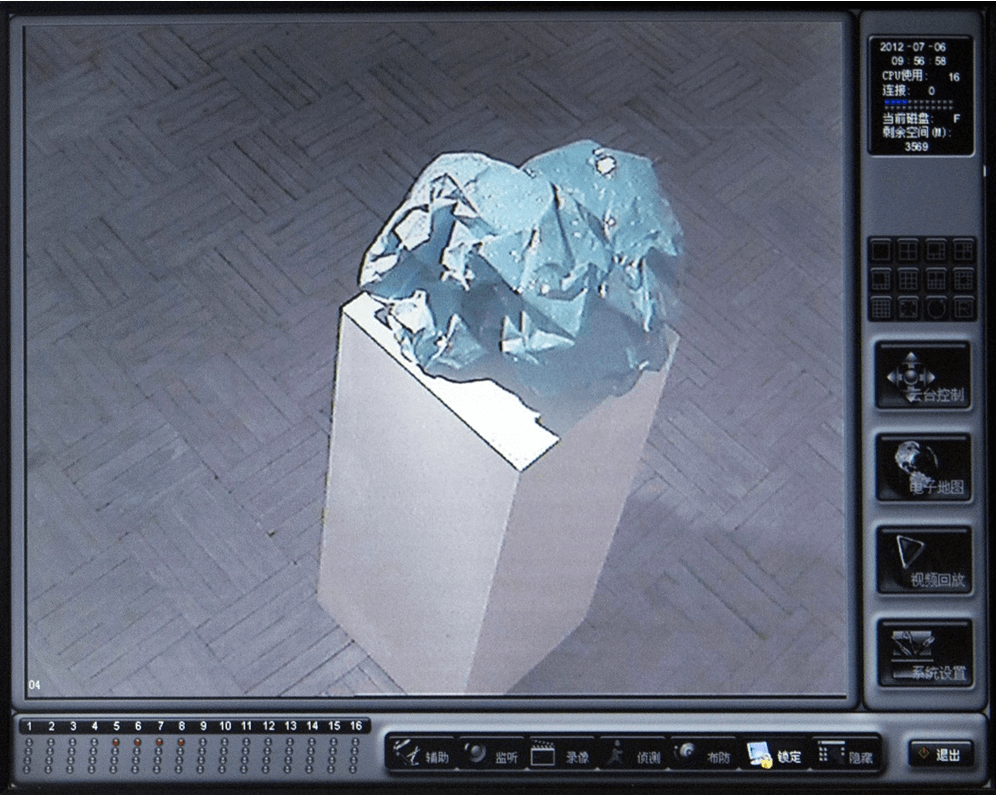
Aspartime: The Weibo project was our first net project. Weibo was something that we were all using a lot [in 2012], it’s a social platform where everyone could post images, or say something. At the time we were preparing to make some micro sculptures that were temporal, flimsy, and only existed in photographs. We can only post flat images on Weibo, which matched with how we imagined these works, and people could conveniently look at our works. We just felt it could be a good platform for displaying our works, so we posted one work everyday.
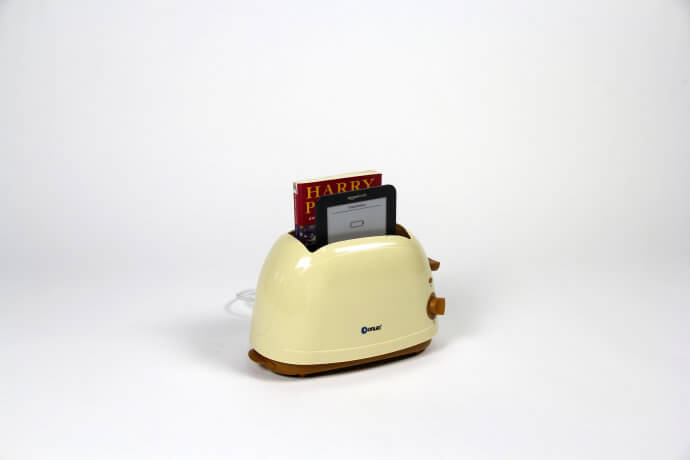
Michelle: Can you give me a few examples of art you were displaying on Weibo? Why were you choosing to show what you did?
Aspartime: We were posting works everyday back then, for 126 days straight. If people are interested to see today what we did in the beginning, they could still find them on our page. Weibo isn’t so hyped as before, but we still post some GIFs once in awhile. They are all images we find online that interest us, it’s a way of creating more traffic and gaining more fans.
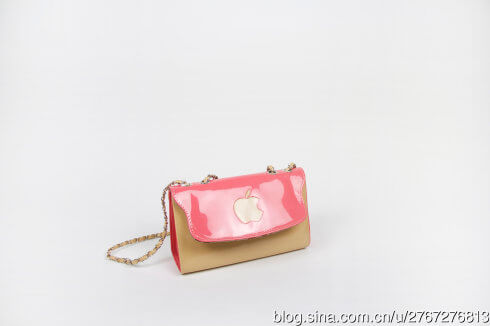
Michelle: In which year and how did you first encounter the Internet in China? What did you think the Internet was and how it could affect your lives from that day forward?
Aspartime: It must’ve been quite early on, the Internet sort of just came into our lives unexpectedly, and now we really cannot do without it. It has become our bond with society. Staying away from the internet would mean hiding out, even the masters are lost in the sea of internet users.
Michelle: When first accessing the Internet, how did you use it in your day-to-day life? How were your peers also using the Internet at that time?
Aspartime: We cannot recall the time we started using the internet, it was probably to play games and buy things, also to use an early social media chatting tool called QQ.
Michelle: When did you start using a VPN in China and how did you find out that you needed one to bypass The Great Firewall? Did this change your impression of the Chinese Internet up to that point?
Aspartime: We started using a VPN when we came back from the UK for the first time. We use it mainly to look up certain things that are happening in the West. China has been a strange place all along, and the Chinese internet is an internet with Chinese characteristics.
Michelle: What is the weirdest thing you have seen someone use the Internet for in China?
Aspartime: I guess we are quite used to all kinds of weird things. There are weird things happening everyday. The internet makes it easy for us to see these things, and the strangest things happening today would just be one out of many. The internet has the power to dissolve everything, no matter how shocking, grand, serious or meaningful they are.
Michelle: Since both of you have studied and lived abroad, you must be familiar with the major differences of the Internet inside of the Great Firewall and the rest of the World Wide Web. From your perspective of both sides of the Great Firewall, what are some differences between the two Webs that stand out most in how netizens interact with the Internet creatively or just pragmatically?
Aspartime: The establishment of the Great Firewall created different social platforms for the two sides of the wall. On the outside, people use Facebook and Twitter, while on the inside, people use Weibo and WeChat; eBay and Amazon on the outside, Taobao on the inside. For us, the Great Firewall just means that extra procedure of getting past that wall while we go online.
Michelle: In 2013 you began an Aspartime Taobao page. What things were you trying to sell on Taobao and why did you specifically choose to use this website in the production and selling of your artworks?
Aspartime: Taobao is an extremely interesting, open free market with a lot of possibilities. You could find all sorts of strange rarities on Taobao. It is the best place to kill time for a satisfying experience. We are loyal customers of Taobao ourselves, we buy all sorts of things there. Opening a Taobao store correlates with how Aspartime works creatively, with a non-professional, “part time job” sort of mentality to market our art. It’s casually structured, sometimes there are products, sometimes there are “new products”.
We sold our works in the store but they are not physical objects. It was divided into two parts – one was the digital “Update” photos. If a customer buys an “Update” piece, we would send him the digital print; the other is the “Ideas” series, where the customers would buy the performances we describe in words, and they would have to carry through the plans themselves.
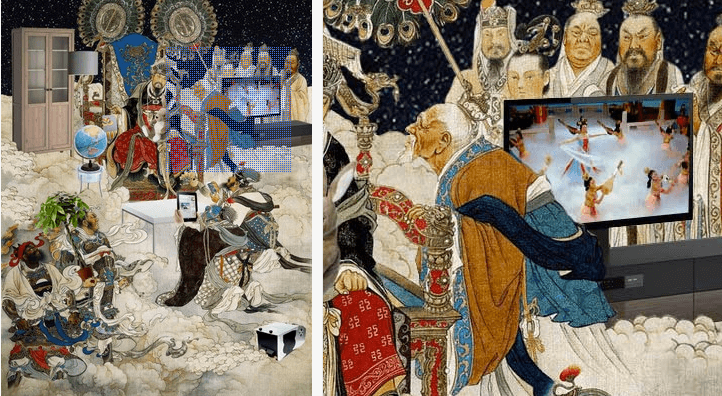
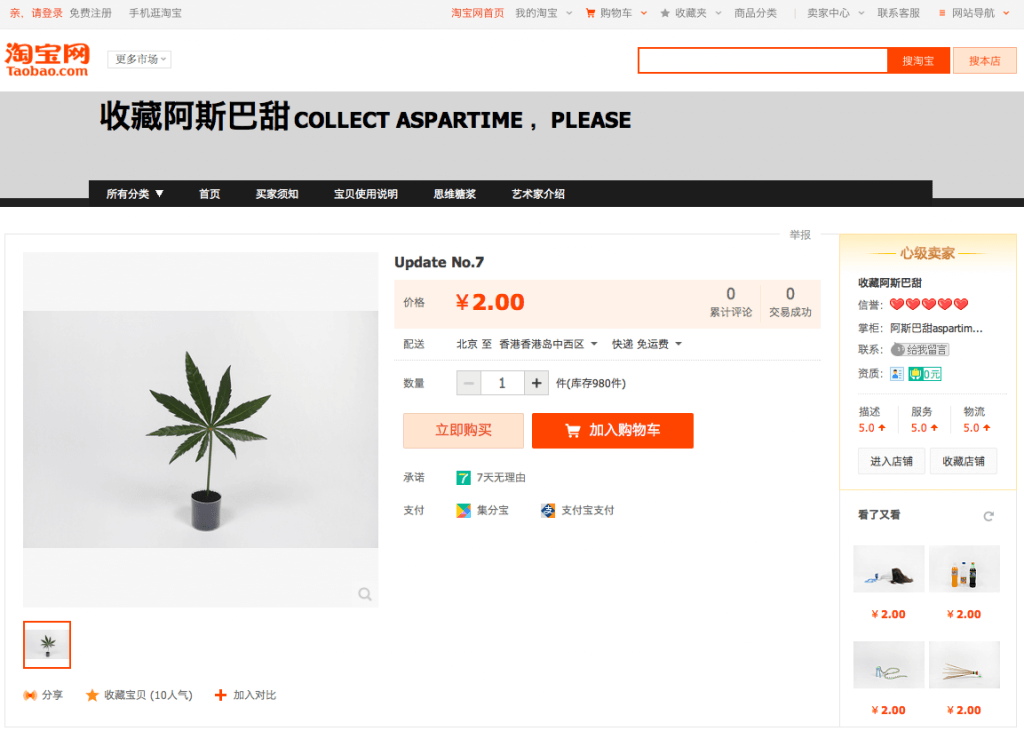
Michelle: When and why did you start making GIFs as an art form in your practice?
Aspartime: Our work exhibited in a group show at Intelligentsia Gallery in 2014 and was our first GIF work. GIFs are little animations that we often see online. Nowadays on WeChat there is also a large amount of GIF emoticons as substitution for our expression through language. We really like these circulated animations. We post the fun ones we find online regularly on our own Weibo page, which has now become our gallery of collected GIFs. GIFs just seemed to be the most natural form of expression while we were preparing for the exhibition at Intelligentsia Gallery.
Michelle: Most people focus on censorship topics when it comes to talking about the Chinese Internet (aka humorously known as the Chinternet). However, obviously there is something special about the Chinese Internet that has drawn you to want to work with it.
Aspartime: All Chinese internet users feel the power of censorship, this has been an object of ridicule all a long. What is magical about the internet is its folksiness and its freedom. Wisdom of the mass is a strong force of mitigation in this kind of system.
Michelle: If you could write a traditional Chengyu [idiom/poem] to describe the Chinese Internet, what four characters would you choose to use to do this?
Aspartime: Xuánmiào mò cè [ 玄妙莫测 ] – Mysterious, you can’t imagine how deep it is. Difficult to guess or comprehend.
媚潇:“阿斯巴甜”这个名字跟你们的艺术创作有什么关系?为什么选择使用这种常用的代糖甜味剂(Aspartame)的同音字(Aspartime)?
阿斯巴甜: 我们觉得艺术家不是一种职业,艺术家应是最自由的存在,兼职更是我们对待艺术的一种态度吧,轻松自然不含防腐剂。不希望被些世俗的怪圈框住。“阿斯巴甜”是人工合成的甜味剂,它的安全性就一直有争议,好与坏,正与反,争论未定。我们觉得还是蛮好玩的,蛮契合我们的趣味。于是aspartame被我们篡改了一个字母,阿斯巴甜Aspartime就成了我们的名字。

媚潇:为什么决定组成“阿斯巴甜”,而不继续以独立艺术家的身份创作?
阿斯巴甜: 我们希望阿斯巴甜是替代艺术家个体创作的一种方式。我们希望阿斯巴甜应该是去个人化的,可以是一个项目,一个活动,一个宣言,一个虚拟,甚至是一个无需理由的存在。
媚潇:身为一对情侣,共同创作的时候会有些什么比较有意思或有挑战性的部分?
阿斯巴甜:创作对我们来说就像是日常的生活,一起创作就像一起逛街,一起做饭,一起打扫,一起锻炼,一起旅游,一起生活。两个人在一起,相互温暖相互关心,真心觉得蛮幸福的。
媚潇:你们小组的创作过程是怎样的?你们是否能够有规律而合拍地共同创作,还是在构造“阿斯巴甜”的时候也有磨合双方独立想法的过程?
阿斯巴甜: 我们分别有自己的方案本,纪录一些最原始的想法和方案,然后讨论,互相否定想法,最终达成一致,最后的想法都是互相斗争妥协的结果。
媚潇:2012年你们曾经在星空间做过一个名为“无处藏身”的展览。展览背后的策展概念是去探索一个人在世界里的定位——“寻找一个处身的地方及生存是我们的一种基本问题”。你们觉得身为中国当代艺术家,你们如何跟这个话题相关联?
阿斯巴甜: 当时我们的作品想要讨论的是艺术作品本身与画廊空间除去展示关系还有什么直接的关系。一件霓虹灯作品是拆解了“星空间”这三个字的笔画,一件是测量了展览射灯的温暖,一件是“无处藏身”的展览海报揉成一个雕塑,还有一件是用了十几个语言描作品信息。我们的4件展示的作品都是围绕星空间做的相关的作品。针对这次展览全新创作的作品其实刻意回避了严肃的艺术课题,那个时期也是我们后来做update和淘宝计划的热身,渐渐明确喜好和方向。
媚潇:你们年间大部分时间在国内还是在国外?你们怎么在这些地方之间分配时间?这样子来回跑对你的艺术创作有什么影响?
阿斯巴甜: 我们刚刚开始这种两地来回跑的日子,这种日子也是一种奇特的经历。应该会对我们产生蛮巨大额度影响的,我们也蛮期待的。一来一回,来回充电,来回释放能量,我们的经历和观念不断的像潮汐冲涮着
媚潇: 2012年5月16日你们开始了你们第一个网上项目“Update微博计划”,通过微博这个平台去展示你们的艺术品。你们是从什么时候开始运用互联网作为在国内不常见的非传统的展示平台?
阿斯巴甜: 微博计划就是我们的第一个网络的计划。是因为微博是当时我们平时都在用的平台,每个人都能在这个平台上发个照片,说段话。当时我们准备做一组微装置,它是临时的,微弱的,在照片里的。而微博只能发平面的图片,这正好和我们设想的作品形式吻合,观众可以很方便的观赏我们的作品。所以我们觉得这可以是作品的很好展示平台,于是就在这个平台上发作品。最后因为微博的纪实性,于是我们就每天在微博上发一件作品。
媚潇: 能不能举几个你们在微博上展示过的作品例子?选择展示这些作品又有什么意义?
阿斯巴甜: 那段时间我们每天都会在微博上发作品,一直发了126天。现在如果谁有兴趣翻看到我们最初的微博,都可以看到那些作品。现在微博没有之前那么狂热了,不过我还是会持续每天发送一些GIF,都是我在网上找到的自己比较喜爱的好玩的图,赚取点击量和粉丝。
媚潇: 你们在微博上的朋友和其他网民对你们在网上展示作品有什么反应?他们是否理解及支持,或抗拒你们这个计划,还是它根本没有引起任何反馈?你们发表的微博曾经自己或被官方删除过么?
阿斯巴甜: 看到我们作品的朋友都觉得蛮有意思的,他们就会关注我们的微博。会有一些朋友留言问这是什么,我们就会跟他们解释。我们的微博没有被官方删除过。
媚潇: 你们是在哪一年和通过什么途径在国内接触到互联网的?那时候你们认为它是什么,而它又是如何从那个时候开始影响到你们的生活?
阿斯巴甜: 应该是蛮早的时间吧,互联网不知不觉的就进入我们的生活了,我们现在真心离不开网络的,它成为了我们和社会的联系的纽带。现在离开网络有点隐居的意思了,叫大隐隐于网络。
媚潇: 刚刚开始使用互联网的时候,你们一般用来做什么?你们那时候的朋友又是如何运用互联网?
阿斯巴甜: 刚开始用网络的时候都不记得了,也许用来打游戏,买东西,还有我们最早的社交软件叫QQ。
媚潇: 你们从什么时候在国内开始使用翻墙软件,你们又是怎么发现你们需要这种软件去越过中国国家防火墙(GFW)?那时候是否改变了你们对中国的互联网的印象?
阿斯巴甜: 翻墙软件就是从英国回国后开始用的,我们翻墙主要就是查看一些国外的资讯什么的。中国一直以来就是一个奇特的国度,中国的互联网就是中国特色的互联网。
媚潇: 你遇见过的国内网民在网上干过最奇怪的事是什么?
阿斯巴甜: 应该见怪不怪了吧。每天都会有各种奇怪的事情发生,网络让人们可以很轻松的看到这些事情,再奇怪的事情放在当下都会觉得只是众多奇怪事情之一,网络强大的消解力量可以消解一切事情。无论多惊人,多宏大,多严肃,多有意义都会消散于无形。
媚潇: 你遇见过的国外网民在网上干过最奇怪的事是什么?
阿斯巴甜: 同上面问
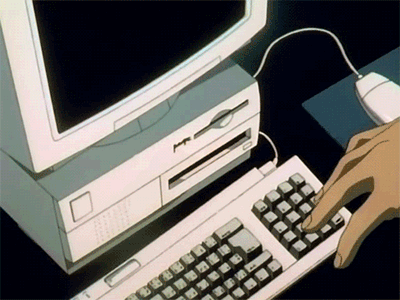
媚潇: 既然你们都在国外读过书和生活过,你们一定对国家防火墙内与被屏蔽的互联网之间的区别熟悉。从你们的角度来看,就网民运用互联网的方式来说,创作上也好,日常使用上也好,在防火墙内和外最大的区别是什么?
阿斯巴甜: 防火墙的设立使得墙里墙外不同的网络的平台,墙外大家用facebook用twitter, 墙内就用微博用微信,墙外用ebay用amazon, 墙内用淘宝用微店。对我来说,防火墙就是我上网时多了一道翻墙的过程。
媚潇: 2013年你们创办了阿斯巴甜淘宝网页。你们那个时候在淘宝上卖的是什么?为什么创作这些作品期间特意选择了运用这个平台?
阿斯巴甜: 淘宝是一个非常有意思,有开放性,有可能性的自由市场。在淘宝上可以买到各种希奇古怪的好玩的东西。淘宝是让人乐在其中打发时间的最佳去处。我们本身也是淘宝的忠实买家,无所不淘。在淘宝开店契合了我们aspartime的创作性质和工作方式,以一种非专业的,partime job的心态去经营自己的艺术,过程无所夹杂,随时有产物,随时添加“新产品”。在淘宝店中我们有卖自己的作品只不过作品不是实物的。它分成了几个部分,一个是电子版的Update的图片,顾客买了update的作品,我们发给他电子版的作品。一个是Ideas系列,顾客买了我们描述的行为,顾客自己去实施。
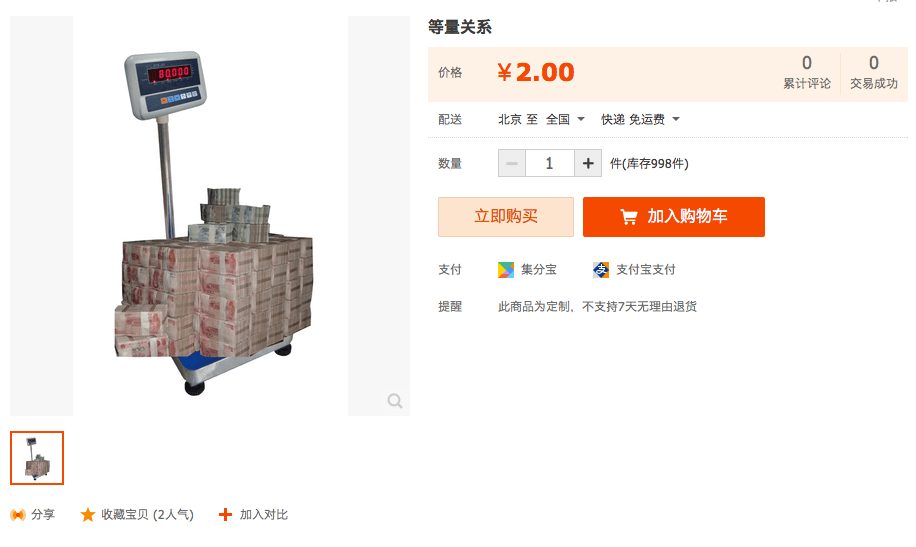
媚潇: 谈到中国的互联网的时候,大多数人都专注其审查制度问题。然而,它有它特殊的地方,也是启发你们在创作中运用它的地方。它还启发了你们在网上或实体创作其他什么作品?
阿斯巴甜: 中国网民都会在网络里感受到审查制度,这个问题一直就网民们嘲讽的对象。网络的神奇之处就在于它的草根性,它的自由性。大众的智慧是这种制度的强有力的消解剂。
媚潇: 如果让你们用一个成语描述国内的互联网,你们会用哪四个字?
阿斯巴甜: 玄妙莫测

译本 / 陈秀炜
Translated by Ophelia S. Chan